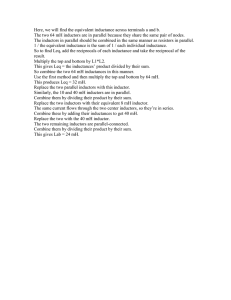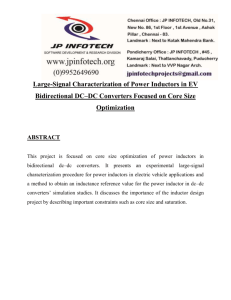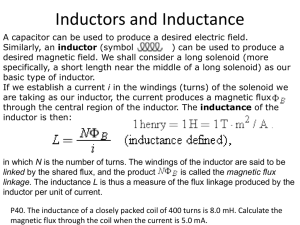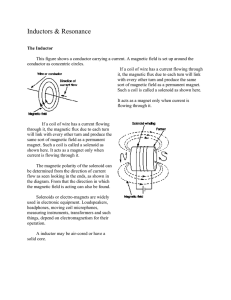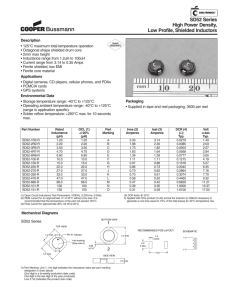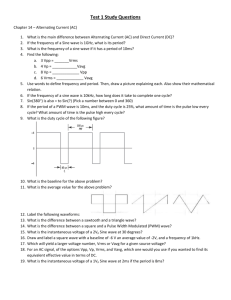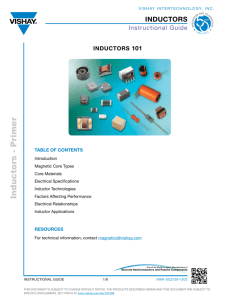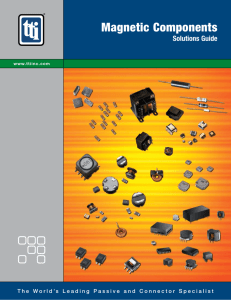Document
advertisement
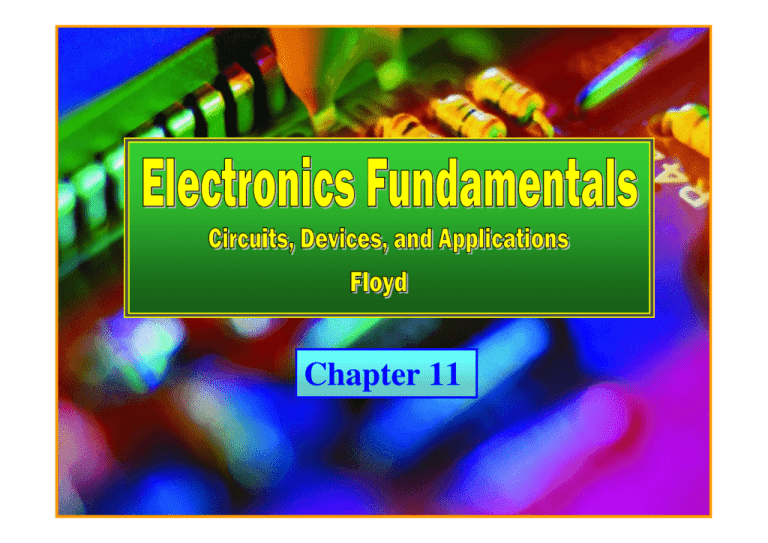
Chapter 11 The Basic Inductor When a length of wire is formed into a coil., it becomes a basic inductor. When there is current in the inductor, a three-dimensional magnetic field is created. A change in current causes the magnetic S N field to change. This in turn induces a voltage across the inductor that opposes the original change in current. The Basic Inductor One henry is the inductance of a coil when a current, changing at a rate of one ampere per second, induces one volt across the coil. Most coils are much smaller than 1 H. The effect of inductance is greatly magnified by adding turns and winding them on a magnetic material. Large inductors and transformers are wound on a core to increase the inductance. Magnetic core Faraday’s law Faraday’s law was introduced in Chapter 7 and repeated here because of its importance to inductors. The amount of voltage induced in a coil is directly proportional to the rate of change of the magnetic field with respect to the coil. Lenz’s law Lenz’s law was also introduced in Chapter 7 and is an extension of Faraday’s law, defining the direction of the induced voltage: When the current through a coil changes and an induced voltage is created as a result of the changing magnetic field, the direction of the induced voltage is such that it always opposes the change in the current. Lenz’s law A basic circuit to demonstrate Lenz’s law is shown. Initially, the SW is open and there is a small current in the circuit through L and R1. L VS SW + R1 − − + R2 Lenz’s law SW closes and immediately a voltage appears across L that tends to oppose any change in current. L + VS − + SW R1 R2 − − + Initially, the meter reads same current as before the switch was closed. Lenz’s law After a time, the current stabilizes at a higher level (due to I2) as the voltage decays across the coil. L VS SW + R1 R2 − − + Later, the meter reads a higher current because of the load change. Practical inductors In addition to inductance, actual inductors have winding resistance (RW) due to the resistance of the wire and winding capacitance (CW) between turns. An equivalent circuit for a practical inductor CW including these effects is shown: Notice that the winding resistance is in series with the coil and the winding capacitance is in parallel with both. RW L Types of inductors There are a variety of inductors, depending on the amount of inductance required and the application. Some, with fine wires, are encapsulated and may appear like a resistor. Common symbols for inductors (coils) are Air core Iron core Ferrite core Variable Factors affecting inductance Four factors affect the amount of inductance for a coil. The equation for the inductance of a coil is N 2µ A L= l where L = inductance in henries N = number of turns of wire µ = permeability in H/m (same as Wb/At-m) l = coil length on meters What is the inductance of a 2 cm long, 150 turn coil wrapped on an low carbon steel core that is 0.5 cm diameter? The permeability of low carbon steel is 2.5 x10−4 H/m (Wb/At-m). 2 2 A = πr = π ( 0.0025 m ) = 7.85 × 10−5 m 2 N 2µ A L= l 2 (150 t ) ( 2.5 ×10−4 Wb/At-m )( 7.85 ×10−5 m 2 ) = 0.02 m = 22 mH Practical inductors Inductors come in a variety of sizes. A few common ones are shown here. Encapsulated Torroid coil Variable Series inductors When inductors are connected in series, the total inductance is the sum of the individual inductors. The general equation for inductors in series is LT = L1 + L2 + L3 + ...Ln If a 1.5 mH inductor is connected in series with an 680 µH inductor, the total inductance is 2.18 mH L1 1.5 mH L2 680 µH Parallel inductors When inductors are connected in parallel, the total inductance is smaller than the smallest one. The general equation for inductors in parallel is LT = 1 1 1 1 1 + + + ... + L1 L2 L3 LT The total inductance of two inductors is LT = 1 1 1 + L1 L2 …or you can use the product-over-sum rule. Parallel inductors If a 1.5 mH inductor is connected in parallel with an 680 µH inductor, the total inductance is 468 µH L1 1.5 mH L2 680 µH Inductors in dc circuits When an inductor is connected in series with a resistor and dc source, the current change is exponential. Vinitial t 0 Inductor voltage after switch closure Ifinal R L 0 Current after switch closure t Inductors in dc circuits The same shape curves are seen if a square wave is used for the source. Pulse response is covered further in Chapter 20. VS VL R VS L VR Universal exponential curves L τ= R 100% 95% 98% 99% 86% 80% Percent of final value Specific values for current and voltage can be read from a universal curve. For an RL circuit, the time constant is Rising exponential 63% 60% 40% 37% Falling exponential 20% 14% 5% 0 0 1τ 2% 2τ 3τ 4τ Number of time constants 1% 5τ Universal exponential curves The curves can give specific information about an RL circuit. Read the rising exponential at the 67% level. After 1.1 τ 95% 99% 63% 60% 40% 37% 20% 14% 5% 0 0 98% 86% 80% Percent of final value In a series RL circuit, when is VR > 2VL? 100% 1τ 2% 2τ 3τ 4τ Number of time constants 1% 5τ Universal exponential curves The universal curves can be applied to general formulas for the current (or voltage) curves for RL circuits. The general current formula is i =IF + (Ii − IF)e−Rt/L IF = final value of current Ii = initial value of current i = instantaneous value of current The final current is greater than the initial current when the inductive field is building, or less than the initial current when the field is collapsing. Inductive reactance Inductive reactance is the opposition to ac by an inductor. The equation for inductive reactance is X L = 2πfL The reactance of a 33 µH inductor when a frequency of 550 kHz is applied is 114 Ω Inductive phase shift When a sine wave is applied to an inductor, there is a phase shift between voltage and current such that voltage always leads the current by 90o. VL 0 90° I 0 Power in an inductor True Power: Ideally, inductors do not dissipate power. However, a small amount of power is dissipated in winding resistance given by the equation: Ptrue = (Irms)2RW Reactive Power: Reactive power is a measure of the rate at which the inductor stores and returns energy. One form of the reactive power equation is: Pr=VrmsIrms The unit for reactive power is the VAR. Q of a coil The quality factor (Q) of a coil is given by the ratio of reactive power to true power. I2XL Q= 2 I RW For a series circuit, I cancels, leaving XL Q= RW
